Hawker Siddeley Nimrod
| Nimrod | |
|---|---|
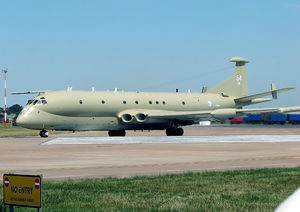 |
|
| RAF Nimrod MR2 taxis for takeoff | |
| Role | Maritime patrol aircraft |
| Manufacturer | Hawker Siddeley BAE Systems |
| First flight | May 1967 |
| Introduced | October 1969 |
| Retired | 26 March 2010 (MR2)[1] |
| Status | MR2 Inactive, R1 active until 2011, MRA4 due in 2012 |
| Primary user | Royal Air Force |
| Number built | 49 (+2 prototypes) |
| Developed from | de Havilland Comet |
The Hawker Siddeley Nimrod is a maritime patrol aircraft developed and built in the United Kingdom. It is an extensive modification of the de Havilland Comet, the world's first jet airliner. It was originally designed by de Havilland's successor, Hawker Siddeley, now a part of the BAE Systems company. The major role of the Nimrod is a warplane in anti-submarine warfare (ASW), though it also has the secondary role in ocean surveillance and in carrying anti-ship missiles to use against surface ships.
A major modification of the design of the "Comet 4" was the installation of a large weapons bay in the bottom of its fuselage - a bay that can carry and drop anti-submarine torpedoes, naval mines, depth charges, aerial bombs, and other munitions. The Nimrod's sonobuoys for tracking submerged submarines are dropped through tubes in the rear of its fuselage.
The Nimrod can also carry guided missiles suspended from hard points beneath its wings. These include Harpoon missiles for attacking hostile surface ships, and Sidewinder air-to-air missiles for self-defence are carried.
The Nimrod MR1/MR2 was the Royal Air Force's primary maritime patrol aircraft (MPA) from the early 1970s, when it replaced the antiquated piston-engined Avro Shackleton, until March 2010[2]. The RAF also uses the Nimrod R1 variant in an electronic intelligence gathering (ELINT) role. The Nimrod MRA4, a remanufactured MR2 with new wings, engines and avionics, was originally scheduled to replace the MR2 in April 2003, but is now expected to take over the role of the older model in late 2012. In the meantime the Ministry of Defence has announced that "a variety of different aircraft", both fixed-wing planes and helicopters, will be used[2].
Contents |
Development
MR1
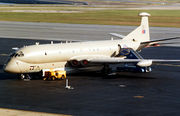
The development of the Nimrod patrol plane began in 1964 as a project to replace the antiquated Avro Shackletons. The Nimrod design was based on that of the "Comet 4" civil airliner which had reached the end of its market life (the first two RAF aircraft were unfinished Comets). The Comet's turbojet engines were then replaced with Rolls-Royce Spey turbofans for better fuel efficiency, particularly at the low altitudes required for maritime patrol. Major fuselage changes were made, including an internal weapons bay, an extended nose for radar, a new tail with electronic warfare (ESM) sensors mounted in a bulky fairing, and a MAD (Magnetic anomaly detector) boom. After the first flight in May 1967, the RAF ordered 46 Nimrod MR1s. The first example (XV230) entered service in October 1969.[3] Five squadrons were eventually equipped with the MR1.
R1
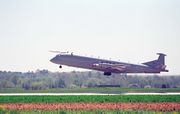
Three Nimrod aircraft were adapted for the Signals intelligence role, replacing the Comet C2s and Canberras of No. 51 Squadron in May 1974. The R1 is distinguished from the MR2 by the lack of a MAD boom. Only since the end of the Cold War has the role of the aircraft been officially acknowledged, these were once described as "radar calibration aircraft". The R1s have not suffered the same rate of fatigue and corrosion of the MR2s and will continue in service long after the MR2 is replaced by the MRA4. New Bombardier Sentinel R1 (ASTOR) aircraft due for delivery from mid 2004 may take on some duties performed by the R1. One R1 has been lost in a flying accident since the type's introduction; this occurred in May 1995 during a flight test after major servicing, at RAF Kinloss. To replace this aircraft an MR2 was selected for extensive conversion, undertaken by BAE Systems at the Woodford factory, to R1 standard, and entered service in December 1996.
The Nimrod R1 is based at RAF Waddington in Lincolnshire, England and flown by 51 Sqn. The remaining Nimrod R1's will be retired in March 2011, and may be replaced by Boeing RC-135 Rivet Joint Aircraft around 2014.
MR2
Starting in 1975, 32 aircraft were upgraded to MR2 standard, including modernisation of the electronic suite and (as the MR2P) provision for in-flight refuelling and additional ESM pods on the wingtips. The in-flight refuelling capability was introduced during the Falklands War, as well as hardpoints to allow the Nimrod to carry the AIM-9 Sidewinder missile (giving rise to the aircraft being called "the largest fighter in the world") for use against Argentine Air Force's Boeing 707 which were configured for maritime patrol/surveillance duties shadowing the British naval task force.[4] Eventually all MR2s gained refuelling probes and the "P" designation was dropped.
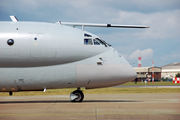
The Nimrod MR2 carries out three main roles - Anti-Submarine Warfare (ASW), Anti-Surface Unit Warfare (ASUW) and Search and Rescue (SAR). Its extended range enables the crew to monitor maritime areas far to the north of Iceland and up to 4,000 km out into the Western Atlantic. With Air-to-Air Refuelling (AAR), range and endurance is greatly extended. The MR2 is a submarine killer carrying up to date sensors and data processing equipment linked to the weapon systems. In addition to weapons and sonobuoys, a searchlight is mounted in the starboard wing pod for Search and rescue (SAR) operations.
The crew consists of two pilots and one flight engineer, two navigators (one tactical navigator and a routine navigator), one Air Electronics Officer (AEO), the sonobuoy sensor team of two Weapon System Operators (WSOp ACO) and four Weapon System Operators (WSOp EW) to manage passive and active electronic warfare systems. Two of the WSOps will be used as observers positioned at the port and starboard beam lookout windows when flying in dense air traffic.
The MR2 has the longest bomb bay of any NATO aircraft.
The Nimrod MR2 was based at RAF Kinloss in Scotland and flown by 201, 120 and 42(R) Squadrons. First maintenance of the MR2 was carried out by the Nimrod Line Sqn. Software Support for the MR2 was carried out by the Nimrod Software Team also based at RAF Kinloss. The Nimrod MR2 aircraft was withdrawn on 31 March 2010, a year earlier than planned, for financial reasons.[5][6] The last official flight of the MR2 Nimrod took place on 26th May 2010, with XV229 flying from RAF Kinloss to Kent International Airport, Manston in Kent, where it will be used by the nearby MOD Defence Fire Training and Development Centre as a evacuation training airframe.
AEW3
| Nimrod AEW3 Hi-res cutaway | |
|---|---|
| Nimrod AEW3 Hi-res cutaway by Flight Global. | |
In the mid-1970s the Nimrod's duties were expanded to include Airborne Early Warning and Control (AEW) — again as a replacement for the Lancaster-derived, piston-engined Shackleton which was still in service in that role. The aircraft were modified by British Aerospace at the former Avro plant at Woodford, Greater Manchester to house the GEC Marconi radars in a bulbous nose and tail. From the start of the first flight trials in 1982 the Nimrod AEW3 project was plagued by cost over-runs and problems with the GEC 4080M computer used for the Mission System Avionics (MSA).[7] Eventually, the MoD realised that the cost of developing the radar system to achieve the required level of performance was prohibitive and the probability of success very uncertain, and in December 1986 the project was cancelled. The RAF eventually received seven Boeing E-3 Sentry aircraft instead, with proven radar performance, and electronic enhancements to the original USAF systems to address UK-specific requirements. Of the 11 RAF Nimrods (8 new airframes and 3 redeployed ex-203 Sqn following the closure of RAF Luqa)[8] that were selected for conversion to AEW3 standard, none returned to the maritime reconnaissance role: all were eventually reduced for spares to support the maritime Nimrod fleet.
MRA4
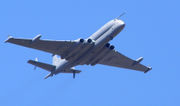

In 1992 the RAF started a Replacement Maritime Patrol Aircraft (RMPA) procurement programme to replace the Nimrod MR2 aircraft. To meet the requirement BAE proposed rebuilding each Nimrod MR2 with new engines and electronics which it called Nimrod 2000. The RAF considered bids from Lockheed with its P-3 Orion, Loral Corp. with rebuilt ex-US Navy Orions, and Dassault with the Atlantique 3, but in December 1996 awarded the contract to BAE for the Nimrod 2000 as the Nimrod MRA4.[9]
The MRA4 is essentially a new aircraft, with current-generation Rolls-Royce BR710 turbofan engines, a new larger wing, and fully refurbished fuselage. Much larger air intakes are required because the airflow of the BR710 engine is significantly higher than that of the original Spey 250. The rebuilt aircraft borrows heavily from Airbus technology; the wings are designed and manufactured by BAE Systems (a former Airbus partner) and the glass cockpit is derived from that of the Airbus A340.
The scheduled date of entry into service for the MRA4 was April 2003.[10] However, development proved far more protracted than anticipated and, as of March 2010[update], first delivery, for training, is scheduled for July 2010, with the aircraft entering service in autumn 2012.[11] The contract was initially for the supply of 21 rebuilt Nimrods. Flight Refuelling Limited were contracted to undertake the conversions to MRA 4 standard, but early in the contract BAE discovered that the Nimrod airframes supplied by the RAF for refurbishing were not built to a common standard, which considerably complicated the refurbishment process. The task of converting the existing airframes was transferred to BAE Systems Woodford.
Due to technical problems the project was halted after a design fault was discovered with the new wings. This allowed BAE Systems to design a modification to the wing design before the programme was restarted. During this time wing assembly was transferred from Chadderton factory to the Woodford site.
The British House of Commons Defence Committee, in July 2004, reported a forecast cost of £3.5 billion compared to £2.8 billion approved at Main Gate [12]. They noted that the date of entry into service had slipped to 2009, compared to the date of 2003 approved at "Main Gate" [13].
Following public recriminations between the Ministry of Defence and BAE, the development contract was renegotiated for a reduced number of 18 aircraft. Officially this is attributed to the increased capability and availability MRA4 will provide, but it has been suggested that this is in effect compensation to BAE, who had to absorb the cost increases.
Announcing plans for the future of the British military on 21 July 2004, the Defence Secretary Geoff Hoon detailed plans to reduce the upgrade programme to cover only 16 aircraft and suggested that an eventual fleet of twelve might suffice. On 18 July 2006, BAE received a contract worth £1.1 billion for 12 MRA4s. This involves the completion of three development aircraft and conversion of nine more to production standard. In response to the news of the production contract, Mike Turner, Chief Executive of BAE Systems, said: "The new NIMROD MRA4 is a world leader in terms of maritime patrol platforms and it will give the UK at least 30 years of adaptable capability in maritime reconnaissance and attack operations." The Nimrod MRA4 mission systems enable the crews to gather, process and display up to 20 times more technical and strategic data than in the current aircraft, the MR2. The Searchwater 2000 radar is capable over land as well as water: it can sweep an area the size of the UK every 10 seconds.
On 30 July 2007, the Nimrod MRA4 successfully released the Sting Ray torpedo for the first time. The safe separation trial to demonstrate the ability to deploy this weapon from the MRA4 bomb bay took place at Aberporth range off the coast of West Wales during the 75th flight of development aircraft PA02. Three MRA4 development aircraft have been built and are undergoing an intensive flight-test programme. PA02 achieved its first flight in December 2004 and is being used to test elements of the mission system and the air vehicle.[14][15]
In September 2007, another major event passed with the handover of the Aircraft Synthetic Training Aids (ASTA) from Thales Training & Simulation to BAE Systems. ASTA provides the RAF with a sophisticated synthetic training suite that will allow them to transfer training from the aircraft to the ground-based training system. This will increase the availability of the aircraft for operational missions while optimising flight and mission crew performance and capabilities.[16]
By the time of the maiden flight of the first production aircraft, on 10 September 2009[17], the number of MRA4s to be delivered had been reduced from 21 to 9, making the cost per aircraft quadruple that of the original estimate. Each MRA4 will cost UK taxpayers at least £400m (USD660m at August 2009 rates). This has been equated to the cost of three Nimrod MRA4s to one NASA Space Shuttle.[18]
On 15 December 2009, the Ministry of Defence announced that the introduction to service of the Nimrod MRA4 will be delayed until 2012 as part of wide-ranging defence spending cuts.[19]
As of March 2010[update], the first of nine new Nimrod MRA4 had been delivered to the RAF for a series of acceptance tests. Expected to reach initial operational capability in October 2012, the MRA4 will operate out from its main base at Kinloss, Scotland.[20] By 2012, the RAF is expected to take delivery of the final MRA4 aircraft.[21]
Design
The Nimrod is the first jet-powered Maritime Patrol Aircraft (MPA). Earlier MPA designs used piston engines or turboprop engines to improve fuel economy and to allow for lengthy patrols at low altitudes, as with the Lockheed P-3 Orion. Jet engines are most economical at high altitudes and less economical at low altitudes. However, the aircraft can travel to the operational area at high altitude; in a jet aircraft this is not only economical on fuel but fast compared to earlier piston aircraft. On reaching the patrol area the Nimrod descends to its working altitude.
On patrol at high weight all four engines are used, but as fuel is consumed and weight is reduced first one and then a second engine is shut down, allowing the remaining engines to be run at an efficient RPM rather than running all engines at less efficient RPM. A "rapid start" system is fitted should the closed-down engines need to be restarted quickly; instead of relying only on ram air for restarting an engine, compressor air from a live engine is used in a starter turbine which rapidly accelerates the engine being started. All engines are used for travel back to base at high altitude.
Operational history
At first the crews, who were transferred to the Nimrod from the piston-engine Avro Shackletons, were not enthusiastic with the craft, mainly because its sensor suite was only marginally superior to the Shackleton's. In fact most sensors were the same, though the plane had a new digital data fusion computer. The plane gave sterling service during the "Cod Wars" between Iceland and the UK over fishing rights. During the Falklands war (Operation Corporate), several Nimrods combed the sea for enemy submarines. The Nimrods took part in Operation Granby (the Gulf War 1990/1991), the NATO operations against Serbia in 1999, Operation Telic (the Iraq war in 2003 and beyond) and the campaign in Afghanistan. They also took part in several search and rescue (SAR) operations in the North Sea.
Search and rescue
Since the introduction of the Nimrod into service one aircraft from each of the squadrons on rotation has been available for search and rescue operations at one-hour standby.[22] The standby aircraft carries two sets of Lindholme Gear in the weapons bay.[22] Usually one other Nimrod airborne on a training mission would also carry a set of Lindholme Gear.[22] As well as using the aircraft sensors to find aircraft or ships in trouble, it was used to find survivors in the water, with a capability to search areas of up to 20,000 square miles (52,000 km2).[22] The main role would normally be to act as on-scene rescue co-ordinator to control ships, fixed-wing aircraft, and helicopters in the search area.[22]
Because of the search and rescue role, Nimrod aircraft often appear in the media in connection with major rescue incidents.[22] In August 1979 a number of Nimrods were involved in finding competitors in distress in the disaster-stricken 1979 Fastnet race, and directing helicopters to the scene.[22] The Alexander L. Kielland was a Norwegian semi-submersible drilling rig that capsized whilst working in the Ekofisk oil field in March 1980 killing 123 people.[22] Six different Nimrods searched for survivors and took it in turn to provide a rescue co-ordination role,[22] involving the control of 80 surface ships and twenty British and Norwegian helicopters; control became particularly important as the visibility deteriorated.[22] In an example of the search capabilities, in September 1977 when an attempted crossing of the North Atlantic in a Zodiac inflatable dinghy went wrong, a Nimrod found the collapsed dinghy and directed a ship to it.[22]
Offshore Tapestry
Tapestry is a codeword for the activities by ships and aircraft that protect the United Kingdom's Sovereign Sea Areas, including the protection of fishing rights and oil and gas extraction.[22] Following the establishment of a 200 nautical miles (370 km) Exclusive Economic Zone (EEZ) at the beginning of 1977 the Nimrod fleet was tasked with patrolling the 270,000 square miles (700,000 km2) area. The aircraft would locate, identify, and photograph vessels operating in the EEZ.[22] The whole area was normally covered every week, with each vessel being photographed.[22] The aircraft would also check and communicate with all oil and gas platforms.[22] In 1978 a Nimrod arrested an illegal fishing vessel from the air in the Western Approaches and made the vessel proceed to Milford Haven for further investigation. During the Icelandic Cod Wars of 1972 and 1975-1976 the Nimrod aircraft operated with Royal Navy surface vessels protecting British fishing fleets.[22]
Operators
| Squadron | Dates | Aircraft | Station |
|---|---|---|---|
| 42 Squadron | 1971-1984 | Nimrod MR1 | RAF St Mawgan |
| 1983-2010 | Nimrod MR2 | RAF St Mawgan, RAF Kinloss | |
| 51 Squadron | 1971-current | Nimrod R1 | RAF Waddington |
| 120 Squadron | 1970-1982 | Nimrod MR1 | RAF Kinloss |
| 1981-2010 | Nimrod MR2 | RAF Kinloss | |
| 201 Squadron | 1970-1983 | Nimrod MR1 | RAF Kinloss |
| 1982-2010 | Nimrod MR2 | RAF Kinloss | |
| 203 Squadron | 1971-1977 | Nimrod MR1 | RAF Luqa |
| 206 Squadron | 1970-1981 | Nimrod MR1 | RAF Kinloss |
| 1980-2005 | Nimrod MR2 | RAF Kinloss | |
| 236 OCU | 1970-1992 | Nimrod MR1 and MR2 | RAF St Mawgan |
Aircraft on display
MR2 variants
- XV226 - Bruntingthorpe Aerodrome
- XV231 - Manchester airport viewing park
- XV232 - Coventry airport
- XV240 - Gate guardian at RAF Kinloss
- XV250 - Yorkshire Air Museum
- XV255 - City of Norwich Aviation Museum
AEW3
- Cockpit at Solway air Museum, Carlisle
Accidents and incidents
Five Nimrods have been lost in accidents[23][24] :
- On 17 November 1980, a Nimrod MR2 crashed near RAF Kinloss after three engines failed following multiple birdstrikes, killing both pilots. The remaining crew survived.[25]
- On 3 June 1984, a Nimrod MR2 stationed at RAF St Mawgan suffered extensive damage when a reconnaissance flare ignited in the bomb bay during flight. The aircraft successfully returned to base but was subsequently written-off due to fire damage. There were no casualties.[26]
- On 16 May 1995, XW666 a Nimrod R1 from RAF Waddington ditched in the Moray Firth 4.5 miles (7.2 km) from Lossiemouth after suffering an engine fire whilst on a post-servicing test flight from RAF Kinloss. The MoD inquiry identified a number of technical issues as the cause. There were no casualties.[27]
- On 2 September 1995, a Nimrod MR2 crashed into Lake Ontario while participating in the Canadian International Air Show, killing the 7 crew members.[28][29]
- On 2 September 2006, a Nimrod MR2 XV230 crashed near Kandahar, Afghanistan, killing 12 airmen, one marine and one soldier — the largest single day loss of UK personnel since the Falklands War. This was the first Nimrod to enter operational service, originally as the MR1 and was upgraded to MR2 standard in the 1980s.[30] On 23 February 2007, the Ministry of Defence took the decision to ground all MR2 aircraft while investigations were carried out on fuel pumps. The MoD were quick to stress that this was not necessarily related to the crash in Afghanistan.[31]
- On 5 November 2007, a mid-air incident took place in XV235 over Afghanistan, when the crew noticed a fuel leak during air to air refuelling operations.[32] After issuing an in-flight mayday, the crew landed the aircraft successfully. This incident is significant, coming only a month before the issue of the report of a Board of Enquiry into the 2 September 2006 fatal accident to XV230 in (likely) similar circumstances. The RAF subsequently suspended air to air refuelling operations for this type.
Specifications
| Nimrod MR1 cutaway and weapon loadout | |
|---|---|
| 1970's cutaway of Nimrod MR1 XV230 retouched by Flight Global in 2006. | |
MR2
General characteristics
- Crew: 12
- Capacity: 24
- Length: 38.65 m (126 ft 9 in)
- Wingspan: 35.00 m (114 ft 10 in)
- Height: 9.14 m (31 ft)
- Wing area: 197.05 m² (2,121 sq ft)
- Empty weight: 39,009 kg (86,000 lb)
- Max takeoff weight: 87,090 kg (192,000 lb)
- Powerplant: 4× Rolls-Royce Spey turbofans, 54.09 kN (12,160 lbf) each
Performance
- Maximum speed: 923 km/h (575 mph)
- Cruise speed: 787 km/h (490 mph)
- Range: 8,340-9,265 km (5,180-5,755 mi)
- Service ceiling: 13,411 m (44,000 ft)
Armament
- Guns: None
- Hardpoints: 2 under-wing pylon stations and an internal Bomb bay holding up to 20,000 lb (9,072 kg) of payload
- Rockets: None
- Missiles:
- Air-to-air missile: 2 AIM-9 Sidewinder (non-standard in RAF service, only mounted on the MR2 during the Falklands War)
- Air-to-surface missile: Nord AS.12, Martel missile, AGM-65 Maverick, AGM-84 Harpoon
- Bombs:
- Depth charges, US-owned B57 nuclear depth bombs (2) (until 1992)[33][34]
- Others:
- Air-dropped Mk.46 torpedoes, Sting Ray torpedoes
- Naval mines
- Sonobuoys
MRA4
General characteristics
- Crew: 10
- Length: 38.6 m (126 ft 9 in)
- Wingspan: 38.71 m (127 ft)
- Height: 9.45 m (31 ft)
- Wing area: 235.8 m2 (2,538 sq ft)
- Empty weight: 46,500 kg (102,515 lb)
- Max takeoff weight: 105,376 kg (232,315 lb)
- Powerplant: 4× Rolls-Royce BR710 turbofans, 68.97 kN (15,500 lbf) each
Performance
- Maximum speed: Mach 0.77, 496 kn (571 mph, 918 km/h)
- Range: 11,119 km (6,910 mi)
- Service ceiling: 12,800 m (42,000 ft)
Armament
- Guns: None
- Hardpoints: 4 under-wing pylon stations and an internal bomb bay holding up to 22,000 lb (9,980 kg) of payload
- Rockets: None
- Missiles:
- Air-to-air missile: 2 AIM-9 Sidewinder (non-standard in RAF service, only mounted on the MR2 during the Falklands War)
- Air-to-surface missile: AGM-65 Maverick, AGM-84 Harpoon, Storm Shadow
- Bombs:
- Others:
- Air-dropped Mark 46 torpedoes, Sting Ray torpedoes
- Naval mines
- Sonobuoys
See also
Related development
Comparable aircraft
- Kawasaki XP-1
- P-3 Orion
- P-8 Poseidon
Related lists
- List of active United Kingdom military aircraft
References
- Notes
- ↑ Nimrod officially retires after three decades, The Daily Telegraph, 26 March 2010
- ↑ 2.0 2.1 BBC: Final air miles for 'spy in the sky' crews , 26 March 2010
- ↑ "Hawker Siddeley HS.801 Nimrod MR1". Flight Global Archive. http://www.flightglobal.com/pdfarchive/view/1970/1970%20-%200153.html. Retrieved 2009-07-28.
- ↑ Brown 1987, p. 110
- ↑ RAF Families Federation website (Retrieved 15 January 2010)
- ↑ "RAF Nimrod MR2 Aircraft Takes Final Flight". Airforce-Technology.Com. 1 April 2010. http://www.airforce-technology.com/news/news81172.html. Retrieved 2 May 2010.
- ↑ "BAe Nimrod AEW 3". Spyflight Website. http://www.spyflight.co.uk/nim%20aew.htm. Retrieved 2008-03-31.
- ↑ http://www.spyflight.co.uk/Nim%20aew.htm
- ↑ Hastings, David. "Nimrod: Origins". Target Lock. http://www.targetlock.org.uk/nimrod/. Retrieved 26 July 2010.
- ↑ "Nimrod MRA4 Replacement Maritime Patrol Aircraft (RMPA)". GlobalSecurity.org. http://www.globalsecurity.org/military/world/europe/nimrod_mra4.htm. Retrieved 2009-02-12.
- ↑ BBC: End of era for old Nimrods, 26 March 2010
- ↑ House of Commons - Defence - Sixth Report
- ↑ "Main Gate": part of the MoD's Acquisition Operating Framework (accessed 4 December 2007
- ↑ [1]
- ↑ [2]
- ↑ [3]
- ↑ Defence Professionals First production Nimrod MRA4 takes to the skies (Retrieved 14 September 2009)
- ↑ [4] (Retrieved 14 September 2009)
- ↑ "Defence Budget reprioritised to support Afghanistan operation". www.mod.uk. Ministry of Defence. 2009-12-15. http://www.mod.uk/DefenceInternet/DefenceNews/EquipmentAndLogistics/DefenceBudgetReprioritisedToSupportAfghanistanOperation.htm. Retrieved 17 December 2009.
- ↑ "House of Commons Written Answers for 16 June 2010". Hansard. 16 June 2010. http://www.publications.parliament.uk/pa/cm201011/cmhansrd/cm100616/text/100616w0010.htm#100616103000022. Retrieved 12 July 2010.
- ↑ "RAF Accepts First Nimrod MRA4 Surveillance Aircraft". Airforce-Technology.Com. 17 March 2010. http://www.airforce-technology.com/news/news79530.html. Retrieved 2 May 2010.
- ↑ 22.00 22.01 22.02 22.03 22.04 22.05 22.06 22.07 22.08 22.09 22.10 22.11 22.12 22.13 22.14 22.15 Chartres 1986, pp. 71-83
- ↑ "ASN Aviation Safety Database results". Aviation Safety Network. http://aviation-safety.net/database/dblist.php?field=typecode&var=282%&cat=%1&sorteer=datekey&page=1+.
- ↑ Aviation Photos: XV257
- ↑ "Accident description". Aviation Safety Network. http://aviation-safety.net/database/record.php?id=19801117-1&lang=en. Retrieved 2006-09-04.
- ↑ "Accident description". Aviation Safety Network. http://aviation-safety.net/database/record.php?id=19840603-0. Retrieved 2008-09-25.
- ↑ "Accident description". Aviation Safety Network. http://aviation-safety.net/database/record.php?id=19950516-0. Retrieved 2008-09-25.
- ↑ "Timeline: Air show crashes". BBC News. 3 June 2001. http://news.bbc.co.uk/1/hi/uk/1367462.stm. Retrieved 2006-09-04.
- ↑ "Accident description". Aviation Safety Network. http://aviation-safety.net/database/record.php?id=19950902-0. Retrieved 2006-09-04.
- ↑ "Inquiry into Afghan crash begins". BBC News. 3 September 2006. http://news.bbc.co.uk/2/hi/south_asia/5309620.stm.
- ↑ "Report on the grounding of MR2 aircraft". BBC News. 23 February 2007. http://news.bbc.co.uk/1/hi/uk/6390737.stm.
- ↑ "New safety fears for RAF Nimrods". BBC NEWS. 2007-11-10. http://news.bbc.co.uk/1/hi/uk/7087223.stm. Retrieved 2008-05-23.
- ↑ http://nuclear-weapons.info/vw.htm#WE.177_other_aircraft
- ↑ http://nuclear-weapons.info/vw.htm#WE.177_OR.1156_&_OR.1178
- Bibliography
- Chartres, John (1986). Modern Combat Aircraft 24 - BAe Nimrod. Shepperton, Surrey, England: Ian Allan. ISBN 0 7110 1575 9.
External links
- Nimrod MRA4 Maritime Reconnaissance Aircraft on Airforce Technology
- Nimrod production and conversion list
- AEW3 Nimrod XV259
|
|||||||||||
|
||||||||||||||